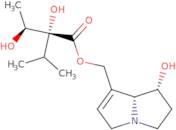
Produktinformation
- 2,3-Dihydroxy-2-(1-methylethyl)-butanoic acid (2,3,5,7a-tetrahydro-1-hydroxy-1H-pyrrolizin-7-yl) methyl ester
- Brn 4324630
- Butanoic acid, 2,3-dihydroxy-2-(1-methylethyl)-, (2,3,5,7a-tetrahydro-1-hydroxy-1H-pyrrolizin-7-yl)methyl ester, (1R-(1a,7(2R*,3S*),7a-beta))-
- Butanoic acid, 2,3-dihydroxy-2-(1-methylethyl)-, (2,3,5,7a-tetrahydro-1-hydroxy-1H-pyrrolizin-7-yl)methyl ester, [1R-[1α,7(2R*,3S*),7aβ]]-
- Butanoic acid, 2,3-dihydroxy-2-(1-methylethyl)-, [(1R,7aR)-2,3,5,7a-tetrahydro-1-hydroxy-1H-pyrrolizin-7-yl]methyl ester, (2R,3S)-
- Nsc 136052
- Retronecine, 7-[(2R,3S)-2,3-dihydroxy-2-isopropylbutyrate]
- [(1R,7aR)-1-hydroxy-2,3,5,7a-tetrahydro-1H-pyrrolizin-7-yl]methyl (2R,3S)-2,3-dihydroxy-2-(propan-2-yl)butanoate
- (+)-Indicine
- Indicine
- Mehr Synonyme anzeigen
Indicin is a biologically active compound that belongs to the group of pyrrolizidine alkaloids. It has a linear calibration curve and can be used for the determination of polymerase chain reaction (PCR) products in DNA samples. Indicin is a possible carcinogen, so it should not be consumed orally. Indicin has been shown to have toxicological effects on rats and mice when it was given intravenously or intraperitoneally, but not when administered orally. Indicin also has potential as an anti-inflammatory agent, which may be due to its ability to bind toll-like receptor 4 (TLR4).
Chemische Eigenschaften
Technische Anfrage zu: 3D-FI161707 Indicin
Wenn Sie ein Angebot anfordern oder eine Bestellung aufgeben möchten, legen Sie stattdessen die gewünschten Produkte in Ihren Warenkorb und fordern Sie dann ein Angebot oder eine Bestellung an aus dem Warenkorb. Es ist schneller, billiger und Sie können von den verfügbaren Rabatten und anderen Vorteilen profitieren.





